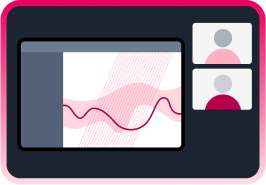Pivot in Pajamas? Teams CAN be Both Aligned and Remote

Over the past month the fast-moving news cycle has dominated nearly all aspects of everyday life, transforming the way individuals around the globe do basic tasks and conduct their everyday business.
Each day there is new information about how long we should practice social distancing or avoid leaving our house, which is adding a new strain on how working people are going to make ends meet. As people conform to these new realities about how to productively work remotely, this event should be seen not as a challenge but more of an opportunity to assess how we can all work smarter and more closely in the new digital work environment.
The coronavirus outbreak is impacting nearly every industry imaginable, and companies that have the ability to shift to working remotely/ from home have already done so. This digital transformation is disrupting the way many companies work and goes far beyond everyday routine.
While organizations may face challenges of interaction, alignment, trust, motivation, and morale, it doesn’t mean that these challenges cannot be overcome.
Companies are working around the clock to implement new programs and strategies like virtual booths to keep their momentum going, during such a pivotal global pandemic that could have long-lasting impacts on the business world.
How Do We Create Alignment and Trust Remotely?
While it is true that life is in constant change, for many of us the pivot to remote work happened a bit too quickly for comfort. Aside from the obvious psychological and logistical challenges of the home office, even those companies with the IT infrastructure for secure productivity are finding their processes and team alignment strained without face-to-face interaction.
The challenge, as I see it, is to create the same level of trust, alignment and interaction remotely that we’ve grown accustomed to in the traditional office setting.
The question is: what does this look like?
Here’s an excellent example. Several weeks ago, as the COVID-19 crisis began to unfold, a major US airline decided to offer its customers increased flexibility when it comes to changing or cancelling flights. The change was first one of policy, but also – crucially – one of digital user experience. To do this, the company took the dramatic step of adding a more prominent “Change Flight” button to their mobile app.
Simple, right? Actually, no. For a multi-billion dollar global player with millions of app users and multiple distributed teams comprising hundreds of workers involved in the various aspects of managing the app – this type of change is anything but simple.
In order to make this work, these teams had to interact, working together to ensure that the functionality did what it was supposed to do, that data flowed correctly, that flight scheduling was adjusted according to fluctuating demand, and that myriad other elements of this highly-complex business worked as they should. Then there was the measurement of the effect of the change – on company revenue, on user experience, on call center volume, and much more.
Achieving this type of quick pivot requires massive inter-team alignment based on streamlined access to trusted and constantly-updated data. This isn’t a given solution even in the best of times. And this especially rings true when working remotely – as this airline’s teams were – every decision made digitally can cause fear and hesitancy unless teams are not only aligned but confident in their alignment.
In the case of the airline, this trust and trans-organizational alignment was achieved remotely using the right technology, together with the right processes – and the move was so successful that other airlines followed suit.
How Do We Facilitate Informal Interaction Remotely?
Another problematic aspect of the remote office experience comes down to informal interaction. So many decisions are taken by the water cooler, in the lunchroom, or just in the hallways. And beyond the day-to-day interaction that drives companies, there’s much wider-scale interaction that drives industries. The same tradeshows and conferences that are being cancelled have historically been hotbeds of game-changing ideas. Generated over drinks and chance tradeshow floor encounters, these ideas spark products, collaborations and even new companies.
So how can we still reap the benefits of this informal interaction, without actually being face-to-face? The virtual conference has long been something companies have toyed with, but which never quite took off. That frankly hasn’t changed, even in the shadow of COVID-19. The problem is that the virtual environment has yet to effectively duplicate mass-scale encounters like tradeshows.
Yet what the web can do is facilitate informal interaction on a smaller scale. For example, we launched a virtual booth a few weeks ago. Like at a tradeshow, individuals or small groups could drop in, take a look, and then break away for small sessions. It was a thoughtful design to not just learn more about their needs and share more about us, but also make it playful like typical trade conferences, for example, by giving away free drinks (to be delivered and consumed in their own homes)!
The Bottom Line
It is very possible to pivot in pajamas. It is even more possible to effectively interact in pajamas. And, as we have seen, it has been absolutely necessary for companies to do both right now. In the shadow of COVID-19, we need to be thinking not just about remote productivity, but also about remote alignment. To be ready for tomorrow, and the inevitable changes coming the day after tomorrow, prepare to pivot in both business casual and pajamas!








